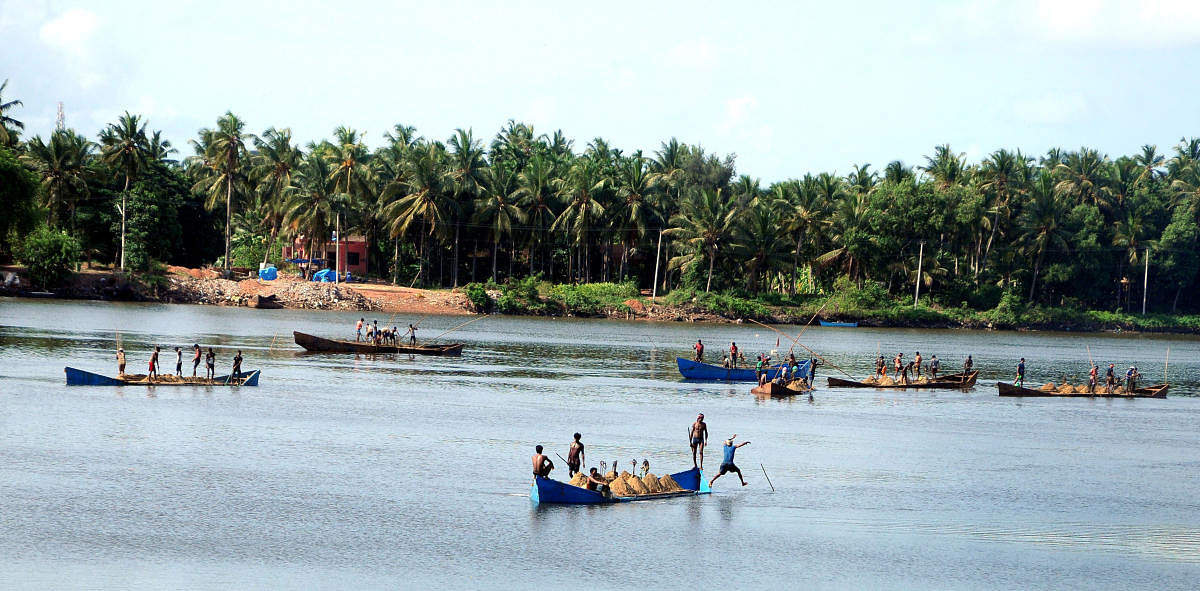
Unbridled illegal sand mining in Dakshina Kannada and Udupi districts over the last few decades has caused irreversible ecological damage, according to environmentalists and experts. Illegal sand mining that thrives on the banks of Netravati, Phalguni, Sita, Swarna and Panchagangavali rivers has affected aquatic life as well as the course of the rivers. Traditionally, sand was extracted sustainably by the fishermen.
However, the increase in demand from major cities of the state and even neighbouring states has resulted in the deployment of heavy boats, earth movers and machinery to extract sand. This has affected the fragile ecosystem of the coastal region. Experts say 90% of the labourers employed in the sector are from North India and the contractors are using heavy metal objects to dig 15 to 25 feet trench to mine sand. In spite of CRZ (Coastal Regulation Zone) rules, local activists claim that 75% of sand mining in the coastal districts is illegal.
According to Dr S G Mayya, former professor of the department of applied mechanics and hydraulics at the National Institute of Technology Karnataka-Surathkal, “The excess extraction of sand affects the normal course of the river. Any variation in the course of the river will either lead to river erosion in a few areas or will lead to flooding during monsoon. Depletion of sand in the river bed causes the deepening of rivers and estuaries, and the enlargement of river mouths, which leads to saline water intrusion,” he said.
For instance, the residents of Pavoor Uliya Kudru, on the outskirts of Mangaluru, are affected by rampant sand mining in the area. The residents were eking out a living by inland fishing and rolling beedis. However, due to rampant sand mining and ecological imbalance, fishing activity has declined in the area and fishermen are forced to take up alternative jobs outside their village.
Referring to the procedures of sand mining, Shashidhar Shetty, general secretary of National Environment Care Federation (NECF) said, though rules mandate the licence holders to extract sand manually from identified blocks, heavy machinery and earth movers are used here in the district.
Further, rules prohibit the extraction of sand in the 500 metre radius on either side of the bridges. It is also mentioned that sand mining should be carried out only in the day time. Unfortunately, all these rules remain only on paper.
Further, he said flouting rules, the trees that come under the buffer zone are felled to facilitate the movement of vehicles to collect sand from the riverside. Shetty said sand extraction is allowed only to remove sand to facilitate easy movement of boats in the water. Unfortunately, the rule has lost its meaning. Sand mining during the monsoons affects the fish species as they lay eggs in the shores. Clams (marwai in Tulu) and a few varieties of crabs that were found in abundance in rivers in the past have declined drastically due to the excessive extraction of sand.
Though Lokayukta police have mentioned the presence of illegal sand mining in Dakshina Kannada at 39 places in Bantwal, Belthangady and Mangaluru taluks, no action has been taken for a blanket ban on illegal sand mining so far.
Though environmentalists claim that the recent collapse of Moolarapattana bridge in Bantwal was due to illegal sand mining, the officials are yet to confirm the same. Sand extraction in the CRZ area is banned from June 12, 2018 to facilitate the breeding of fish during the monsoon. In 2018, from January till date, the officials from the Department of Mines and Geology have raided 19 illegal sand mining places in the district.
It takes nine years for the formation of one inch of sand in riverbed if the rivers flow without any stop. The amount of sand that we have already extracted will take more than 5,000 years to form.
ALSO READ